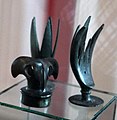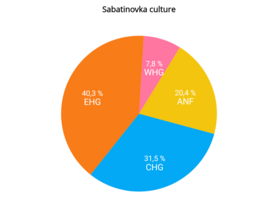Noua-Sabatinovka-Coslogeni complex
| Geographical range | Ukraine, Moldova, Romania |
|---|---|
| Period | Bronze Age |
| Dates | 16th century - 11th century BC |
| Preceded by | Multi-cordoned ware culture, Srubnaya culture, Monteoru culture, Wietenberg culture, Tei culture |
| Followed by | Urnfield culture, Gava culture, Belozerka culture |
The Noua-Sabatinovka-Coslogeni complex was a late Bronze Age archaeological cultural complex located in Ukraine, Moldova and Romania, dating from the 16th to 11th centuries BC, consisting of the closely related Noua, Sabatinovka and Coslogeni cultures.[1][2][3][4]
Characteristics
Representatives of the Noua-Sabatinovka-Coslogeni complex were engaged in agriculture and cattle breeding.[5][6]
Origin
The Sabatinovka culture was formed on the basis of the Multi-Cordon Ware culture,[7][5] there is also the influence of the Srubnaya culture and Monteoru.[8][2] Noua culture and Coslogeni were formed as a result of the fusion of local cultures (Monteoru, Tei and Wietenbrg cultures) with the arriving carriers of the Sabatinovka culture.[6] The relationship of the archaeological complex as part of the Srubnaya culture is a subject of debate.[9]
Successors
Belozerka culture was the successor of the Sabatinovka culture.[8]
Noua culture and Coslogeni was absorbed by Urnfield culture (Gava culture)[2]
Ethnicity
Noua culture and Coslogeni were of Thracian origin, while Sabatinovka culture were of Iranian or Thracian origin.[10][11]
Gallery
- Noua-Sabatinovka-Coslogeni bronze sceptre, Moldova.[12]
- Noua-Sabatinovka-Coslogeni bronze artefacts, Moldova
- Bronze artefacts and casting mould, Ukraine
Genetics
Haplogroups
Noua culture and Sabatinovka culture had a male haplogroup R1a, from female haplogroups were present J1, U8a1a1, U2e1b.[13]
Autosomal DNA
The Noua and Sabatinovka cultures have a genetically similar origin, which distinguishes the Noua culture from its predecessor Monteoru, which was predominantly of Neolithic origin.
- Autosomal DNA Sabatinovka culture
- Autosomal DNA Noua Culture
See also
References
- ^ "Bronze Age". The National Museum of History of Moldova. 2023.
- ^ a b c Boroffka, Nikolaus (2013). "Chapter 47: Romania, Moldova, and Bulgaria". In Harding, Anthony; Fokkens, Harry (eds.). The Oxford Handbook of the European Bronze Age. OUP Oxford. pp. 888–890. ISBN 978-0-19-957286-1.
The Late Bronze Age is marked by two cultural groupings, a south-eastern (Noua-Sabatinovka-Coslogeni) and a western (channelled pottery). ... in Moldova and Ukraine, a specific settlement type of the Noua-Sabatinovka-Coslogeni complex is the so-called ash-mound
- ^ Parzinger, Hermann (2013). "Chapter 48: Ukraine and South Russia in the Bronze Age". In Harding, Anthony; Fokkens, Harry (eds.). The Oxford Handbook of the European Bronze Age. OUP Oxford. ISBN 978-0-19-957286-1.
The absolute chronology of the Noua culture, based on radiocarbon dating and synchronisms with the Carpathian Basin, fits in the fourteenth to thirteenth/twelfth centuries BC. To a large extent this corresponds to the beginnings of the Sabatinovka culture and emphasizes the contemporaneity of the two cultures.
- ^ "Noua culture". Internet Encyclopedia of Ukraine.
- ^ a b Kuzmina, Elena E. (2015). Great Russian Encyclopedia (in Russian) (29 ed.). Moscow. p. 173.
{{cite book}}: CS1 maint: location missing publisher (link) - ^ a b Sava, E.N. (2013). Great Russian Encyclopedia (in Russian) (23 ed.). Moscow. pp. 96–97.
{{cite book}}: CS1 maint: location missing publisher (link) - ^ Kuzmina, Elena E. (2007). Mallory, J. P. (ed.). The Origin of the Indo-Iranians. BRILL. pp. 355–359. ISBN 978-90-04-16054-5.
- ^ a b Kuzmina 2007, pp. 356.
- ^ Kuzmina 2007, pp. 355.
- ^ Kuzmina 2007, pp. 355–359.
- ^ Sulimirski, T. (1985). "The Scyths". In Gershevitch, I. (ed.). The Median and Achaemenian Periods. The Cambridge History of Iran. Vol. 2. Cambridge, United Kingdom: Cambridge University Press. pp. 152–183. ISBN 978-1-139-05493-5.
- ^ "Bronze Age". The National Museum of History of Moldova. 2023.
- ^ Lazaridis, Iosif; Alpaslan-Roodenberg, Songül; Acar, Ayşe; Açıkkol, Ayşen; Agelarakis, Anagnostis; Aghikyan, Levon; Akyüz, Uğur; Andreeva, Desislava; Andrijašević, Gojko; Antonović, Dragana; Armit, Ian; Atmaca, Alper; Avetisyan, Pavel; Aytek, Ahmet İhsan; Bacvarov, Krum (2022). "The genetic history of the Southern Arc: A bridge between West Asia and Europe". Science. 377 (6609): eabm4247. doi:10.1126/science.abm4247. ISSN 0036-8075. PMC 10064553. PMID 36007055. S2CID 251843620.

![Noua-Sabatinovka-Coslogeni bronze sceptre, Moldova.[12]](Https://upload.wikimedia.org/wikipedia/commons/thumb/7/7d/Bronz_preistoric_Chisinau_mai_2014_-0060.jpg/120px-Bronz_preistoric_Chisinau_mai_2014_-0060.jpg)



